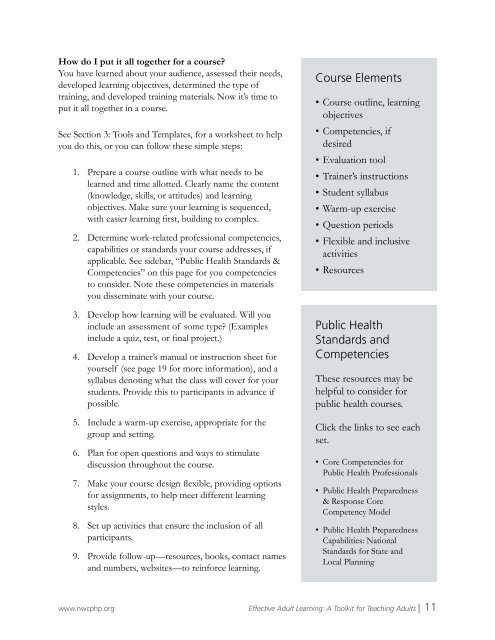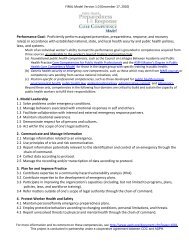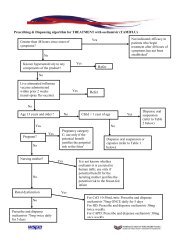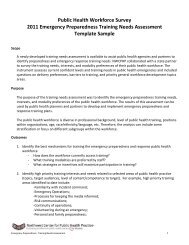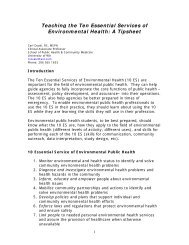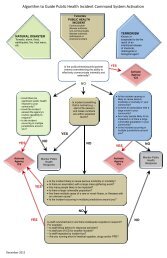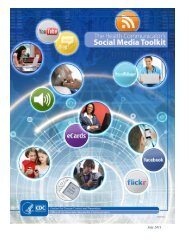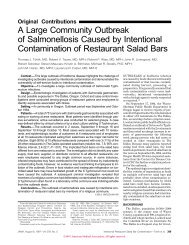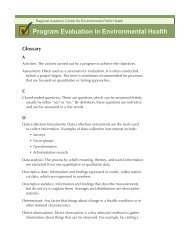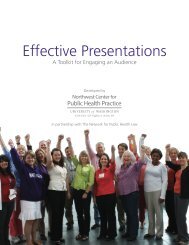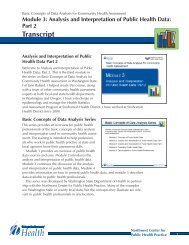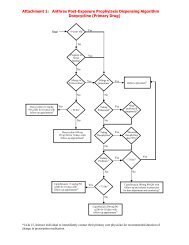Effective Adult Learning - Northwest Center for Public Health Practice
Effective Adult Learning - Northwest Center for Public Health Practice
Effective Adult Learning - Northwest Center for Public Health Practice
Create successful ePaper yourself
Turn your PDF publications into a flip-book with our unique Google optimized e-Paper software.
How do I put it all together <strong>for</strong> a course?<br />
You have learned about your audience, assessed their needs,<br />
developed learning objectives, determined the type of<br />
training, and developed training materials. Now it’s time to<br />
put it all together in a course.<br />
See Section 3: Tools and Templates, <strong>for</strong> a worksheet to help<br />
you do this, or you can follow these simple steps:<br />
1. Prepare a course outline with what needs to be<br />
learned and time allotted. Clearly name the content<br />
(knowledge, skills, or attitudes) and learning<br />
objectives. Make sure your learning is sequenced,<br />
with easier learning first, building to complex.<br />
2. Determine work-related professional competencies,<br />
capabilities or standards your course addresses, if<br />
applicable. See sidebar, “<strong>Public</strong> <strong>Health</strong> Standards &<br />
Competencies” on this page <strong>for</strong> you competencies<br />
to consider. Note these competencies in materials<br />
you disseminate with your course.<br />
3. Develop how learning will be evaluated. Will you<br />
include an assessment of some type? (Examples<br />
include a quiz, test, or final project.)<br />
4. Develop a trainer’s manual or instruction sheet <strong>for</strong><br />
yourself (see page 19 <strong>for</strong> more in<strong>for</strong>mation), and a<br />
syllabus denoting what the class will cover <strong>for</strong> your<br />
students. Provide this to participants in advance if<br />
possible.<br />
5. Include a warm-up exercise, appropriate <strong>for</strong> the<br />
group and setting.<br />
6. Plan <strong>for</strong> open questions and ways to stimulate<br />
discussion throughout the course.<br />
7. Make your course design flexible, providing options<br />
<strong>for</strong> assignments, to help meet different learning<br />
styles.<br />
8. Set up activities that ensure the inclusion of all<br />
participants.<br />
9. Provide follow-up—resources, books, contact names<br />
and numbers, websites—to rein<strong>for</strong>ce learning.<br />
Course Elements<br />
• Course outline, learning<br />
objectives<br />
• Competencies, if<br />
desired<br />
• Evaluation tool<br />
• Trainer’s instructions<br />
• Student syllabus<br />
• Warm-up exercise<br />
• Question periods<br />
• Flexible and inclusive<br />
activities<br />
• Resources<br />
<strong>Public</strong> <strong>Health</strong><br />
Standards and<br />
Competencies<br />
These resources may be<br />
helpful to consider <strong>for</strong><br />
public health courses.<br />
Click the links to see each<br />
set.<br />
• Core Competencies <strong>for</strong><br />
<strong>Public</strong> <strong>Health</strong> Professionals<br />
• <strong>Public</strong> <strong>Health</strong> Preparedness<br />
& Response Core<br />
Competency Model<br />
• <strong>Public</strong> <strong>Health</strong> Preparedness<br />
Capabilities: National<br />
Standards <strong>for</strong> State and<br />
Local Planning<br />
www.nwcphp.org <strong>Effective</strong> <strong>Adult</strong> <strong>Learning</strong>: A Toolkit <strong>for</strong> Teaching <strong>Adult</strong>s | 11


